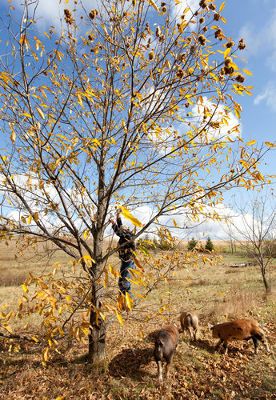
The design of New Forest Farm
 I left you hanging in yesterday's post,
so I figure several of you are probably wondering --- what exactly does
Mark Shepard's farm look like? He based his design on the natural
oak savanna ecosystem, but replaced wild plants with productive,
domesticated species and laid everything out in rows with 23-foot alleys
in between the trees. His primary species include:
I left you hanging in yesterday's post,
so I figure several of you are probably wondering --- what exactly does
Mark Shepard's farm look like? He based his design on the natural
oak savanna ecosystem, but replaced wild plants with productive,
domesticated species and laid everything out in rows with 23-foot alleys
in between the trees. His primary species include:
- American X Chinese chestnuts
--- Those of us further south can just plant Chinese chestnuts, but
Shepard lives too far north for the pure Asian stock to thrive and is
experimenting with hybrids. He plants his chestnuts 12 feet apart.
- Apples --- Since Shepard is trying to make a profit from his farm products, the trickiness of growing blemish-free apples organically
is something he had to figure out. His solution is to use most of
his apples for juice, to plant resistant varieties, to prune high, to
graze in early spring to get rid of diseased leaves, and to let pigs eat
the blemished fruits off the ground. His apples are planted 24 feet apart.
- American X European hazelnuts --- There's been quite a bit more breeding since I wrote this lunchtime series on the topic, but the ideas are the same. In Shepard's system, hazels are planted four feet apart in rows with apples.
- Berries --- Shepard also plants raspberries, blackberries, currants, gooseberries, and grapes in the understory. He trains his grapes onto tree limbs, then prunes the tree leaves above the grapes so the latter get plenty of light.
- Edible and medicinal mushrooms --- These are grown on logs under the trees.
In the alleys between
these trees and shrubs, livestock clip back the grasses and add another
food (and income) source. Shepard recommends using Salatin-style grazing,
with the number of each type of animal based on the number of
cattle. For example, if your farm has just one cow, Shepard
recommends two hogs (Tamworth, Red Wattle, or Berkshires), four turkeys,
one sheep, and variable chickens (with the amount of chickens dependent
on how much you want to feed them). Geese or goats can replace
sheep, although Shepard seemed very anti-goat.
I wish Shepard had given
us many more details on his farm, but this is all I could pull out of
his book! Hopefully it will be enough to give many of you new
ideas, though, just as it set me off on my tree alley experiments.
| This post is part of our Restoration Agriculture lunchtime series.
Read all of the entries: |
Want more in-depth information? Browse through our books.
Or explore more posts by date or by subject.
About us: Anna Hess and Mark Hamilton spent over a decade living self-sufficiently in the mountains of Virginia before moving north to start over from scratch in the foothills of Ohio. They've experimented with permaculture, no-till gardening, trailersteading, home-based microbusinesses and much more, writing about their adventures in both blogs and books.
Want to be notified when new comments are posted on this page? Click on the RSS button after you add a comment to subscribe to the comment feed, or simply check the box beside "email replies to me" while writing your comment.
- Remove comment
- Remove comment
- Remove comment
